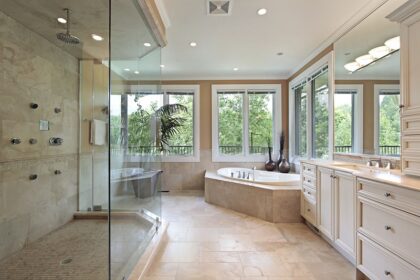Dubai, with its scorching summers and luxurious lifestyle, makes a private pool an almost essential amenity for villa owners. The allure of a shimmering oasis in your backyard is undeniable. However, whether you’re embarking on a brand-new pool construction or a significant renovation, there’s a critical step that many overlook, often to their detriment: snagging.
Snagging, in essence, is the meticulous inspection of a completed or nearing-completion project to identify any defects, deficiencies, or deviations from the agreed-upon plans and quality standards. While commonly associated with entire villa constructions, its importance for pools in Dubai villas is amplified due to a confluence of factors unique to the region and the nature of pool ownership.
The Dubai Context: Where Quality and Climate Intersect
Dubai’s construction boom has brought with it a wide spectrum of contractors. While many are highly reputable, others may cut corners, leading to subpar work. For a pool, this can have far more serious consequences than a cosmetic flaw in a living room.
Furthermore, Dubai’s extreme climate – intense heat, high humidity, and the potential for sandstorms – places immense stress on pool structures and components. A small defect overlooked during construction can rapidly escalate into a major, costly problem under these conditions.
Beyond Aesthetics: The Hidden Dangers of Unsnagged Pools
The reasons why snagging a pool in Dubai is not just advisable but absolutely crucial extend far beyond minor cosmetic touch-ups.
- Structural Integrity and Water Leaks: This is perhaps the most critical concern. A poorly constructed pool shell, inadequate waterproofing, or faulty pipework can lead to insidious water leaks. In Dubai, where water is a precious resource and ground conditions can be challenging, even a small leak can cause:
- Significant Water Loss: Leading to higher utility bills and a constant need for refilling.
- Damage to Surrounding Structures: Leaking water can undermine the foundations of your villa, damage landscaping, and even create hazardous damp conditions.
- Soil Erosion and Subsidence: Over time, continuous water leaks can erode the surrounding soil, potentially leading to ground subsidence and structural instability around your pool and property.
- Costly Repairs: Identifying and rectifying the source of a leak after the pool is filled and operational is often a complex, destructive, and extremely expensive undertaking. It might involve excavating large sections, re-doing tiling, and disrupting your entire outdoor living space for weeks or even months.
- Substandard Plumbing and Filtration Systems: The heart of any healthy pool lies in its plumbing and filtration. Poorly installed pipes, incorrect sizing of pumps and filters, or low-quality components can lead to:
- Poor Water Quality: Inadequate filtration results in cloudy water, algae growth, and an increased need for harsh chemicals, making the pool unpleasant and potentially unhealthy to use.
- Inefficient Operation: A system that isn’t working optimally will consume more electricity, increasing your running costs significantly.
- Premature Equipment Failure: Inferior equipment or improper installation can drastically shorten the lifespan of expensive pumps, filters, and heaters, leading to frequent breakdowns and replacement costs.
- Electrical Safety Hazards: Pools involve a complex interplay of water and electricity. Faulty wiring, inadequate earthing, or non-compliant electrical installations around the pool can be incredibly dangerous, posing a risk of:
- Electric Shocks: A potentially fatal hazard for swimmers and anyone in the vicinity of the pool.
- Equipment Damage: Electrical surges or shorts can damage expensive pool equipment.
- Fire Hazards: Though less common, electrical faults can, in extreme cases, lead to fires.
- Tiling and Finishing Defects: While seemingly cosmetic, poor tiling can have functional implications:
- Loose or Uneven Tiles: Not only unsightly but can create sharp edges, posing a risk of cuts and scrapes to swimmers. They can also indicate underlying issues with the pool shell or adhesive.
- Poor Grouting: Can lead to water ingress behind the tiles, promoting mold growth and eventually causing tiles to de-bond.
- Incorrect Slope for Drainage: Leading to stagnant water on the pool deck, creating slip hazards and breeding grounds for mosquitoes.
- Decking and Surrounding Areas: The area immediately surrounding the pool is equally important for safety and longevity. Snagging should include:
- Proper Drainage: Ensuring water drains away from the pool and villa foundations.
- Even and Non-Slip Surfaces: Crucial for preventing falls, especially with wet feet.
- Adequate Lighting: For safety and ambiance during evening use.
- Secure Fencing and Gates (if applicable): Essential for child safety and complying with local regulations.
- Warranty and Rectification Issues: Identifying defects before final payment and handover gives you significant leverage. Once you’ve signed off and paid in full, getting a contractor to return for rectifications can be a prolonged and frustrating battle. Snagging allows you to compile a definitive list of issues that must be addressed before you take full possession of your sparkling new or renovated pool.
The Snagging Process: What to Look For
While a professional snagging inspector is highly recommended for a thorough assessment, here’s a general checklist of what to look for when building or renovating your pool:
- Pre-Filling Inspection:
- Pool Shell Integrity: Look for cracks, bulges, or uneven surfaces.
- Waterproofing: Ensure membranes and sealants are applied correctly and consistently.
- Plumbing Layout: Verify all pipes are correctly laid, secured, and there are no visible leaks at joints.
- Skimmers, Drains, and Returns: Check for proper installation and alignment.
- Electrical Conduits: Ensure they are properly installed and sealed.
- Tiling: Check for evenness, proper spacing, full grout coverage, and no hollow sounds when tapped.
- Lighting Niches: Ensure they are correctly installed and sealed.
- Post-Filling and Operational Inspection:
- Water Clarity and Circulation: Observe if the water is crystal clear and circulating effectively.
- Pump and Filter Operation: Listen for unusual noises, check pressure gauges, and ensure effective filtration.
- Heater Functionality: If applicable, verify it heats the water to the desired temperature efficiently.
- Lighting Operation: Test all pool lights and surrounding area lights.
- Leak Detection (Post-Filling): While a professional can conduct pressure tests, monitor the water level carefully over several days, accounting for evaporation, to detect any drops that could indicate a leak.
- Decking and Surroundings: Check for proper drainage, even surfaces, and secure railings/fencing.
- Overall Aesthetics: While not critical for safety, ensure the finish meets your expectations.
Conclusion: Invest in Peace of Mind
Building or renovating a pool in a Dubai villa is a significant investment. Don’t let the excitement of the finished product overshadow the importance of meticulous quality control. Snagging is not an optional extra; it’s a fundamental safeguard that protects your investment, ensures the safety of your family and guests, and prevents future headaches and exorbitant repair costs.
By thoroughly snagging your pool before final handover, you’re not just ensuring a beautiful addition to your home; you’re investing in long-term peace of mind and countless hours of worry-free enjoyment in your private Dubai oasis. Don’t skip this crucial step – it’s the difference between a dream pool and a potential nightmare.




